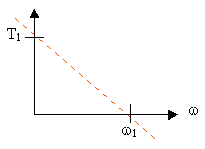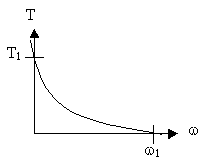![]()
The angular version of Newton’s law of motion, F=ma, is:
![]()
a is the angular acceleration, and so is the rate of change of angular velocity:
hence
Permanent magnet motor
The relationship between the torque and speed of the motor is shown in the graph:

This graph is of the equation:

Therefore, rearrangement gives:


Integrating both sides:

Performing integration of RHS:

Performing integration of LHS using the standard integral
![]()
Gives:

We want to know the time taken for w to reach 63% of w1. The 63% value is actually (1 – 1/e) where ‘e’ is the base of the natural logarithm, 2.7182818…..
Rearranging:


![]()
![]()
Series wound motor
The relationship between the torque and speed of the motor is shown in the graph:

This graph is of the equation:

Therefore, rearrangement gives:
dw / dt = T1(1 - w2/w12) / I
\ 1/(1 - w2/w12) dw = T1 / I dt
Integrating both sides:
ò 1/(1- w2/w12) dw = ò T1 / I dt
Performing integration of RHS:
ò 1/(1- w2/w12) dw =T1/I ´ t
Performing integration of LHS using the standard integral
ò 1/(a2 - x2) dx = 1/(2a) ln [(a + x) / (a –x)]
Gives:
1/2 w1 ln[(w1 + w) / (w1 - w)] = T1/I ´ t
We want to know the time taken for w to reach 63% of w1. The 63% value is actually (1 – 1/e) where ‘e’ is the base of the natural logarithm, 2.7182818…..
Rearranging:
t = 1/2 w1 ln[(w1 + w) / (w1 - w)] ´ I/T1
set w = (1 – 1/e) w1 (63% of w1), then after some cancelling out:
t = 0.931 w1 ´ I/T1